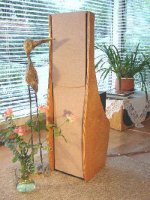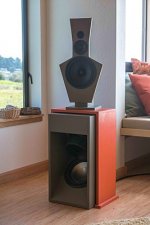Yes, very much in the early testing stage. i do have some GSR tweeters which maybe worth adding.I think if the phase is the same for the mid and tweeters, there shouldn't be an issue, same thing for the material they are made of. If all is comparable besides their Sd, they should sound the same. The issue with pushing drivers beyond 4 octaves is non-linear distortion creeps in. So if your driver starts at 450Hz, then 1st oct is 450-900Hz, 2nd oct is 900-1800Hz, 3rd oct is 1800-3600Hz and the 4th oct is 3600-7200Hz... that is roughly it for the linear or pistonic region. That is ofc if the driver is capable of playing pistonic down to 450Hz.
One shouldn't be worried about using multiple drivers, just like one shouldn't worry about using enough components in the crossover.
Also, I hope you are considering mounting the driver flush with the baffle, looking at the image, you have too many edges on the front which will cause edge diffraction's. If you are only testing, please ignore comment 🙂
Btw, while I am watching Keely's speech on CBT, do you have some more material of what you mentioned to share ?Is it? A dipole with a diaphragm that extends to the edge can give you a large radiator without an extension baffle.
That's a big thing in the dipole world at the moment.
People have been noticing that a raw driver (nude dipole), while it gives the most dipole cancellation it also gives more consistent polars at higher frequencies. I'm not certain of all sides to this but I've noticed that Siegfried Linkwitz recently moved to using a much reduced dipole baffle so that might be a place to start.
Last edited:
Are you thinking of the LXmini series of loudspeakers ? ... so the topic at hand is constant directivity with dipole cancelation ?Siegfried Linkwitz reduced dipole baffle.
Those "fit" my current model of investigation 🙂 ... but I think a U-frame is or can be more beneficial since you then have access to a mechanical bandwidth adjustment vs being limited to an electronic model like the ones you show. The active crossover is no joke.
Looking beyond the driver choices, GR Research is onto something with their NX series, but certainly not first.
Music and Design lovingly call the U-frame for Acoustic Resistance Box - Its still an open frame dipole, the "only" difference is extending the dipole cut off frequency to beyond the driver width or size.
http://musicanddesign.speakerdesign.net/NaO-II-U-frame.html
I ended up at this after extensive research into Aperiodic enclosures.
Looking beyond the driver choices, GR Research is onto something with their NX series, but certainly not first.
Music and Design lovingly call the U-frame for Acoustic Resistance Box - Its still an open frame dipole, the "only" difference is extending the dipole cut off frequency to beyond the driver width or size.
http://musicanddesign.speakerdesign.net/NaO-II-U-frame.html
I ended up at this after extensive research into Aperiodic enclosures.
Yes, John Kreskovsky and Linkwitz have made serious contributions to dipole knowledge.
- Home
- Loudspeakers
- Planars & Exotics
- Why this shape

